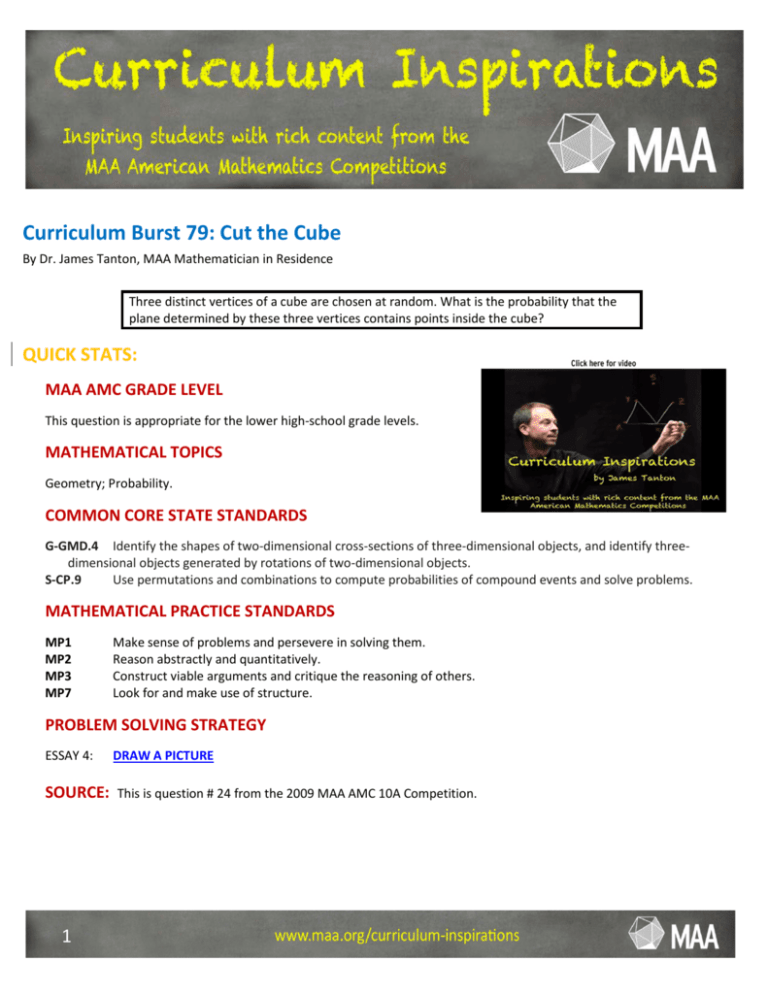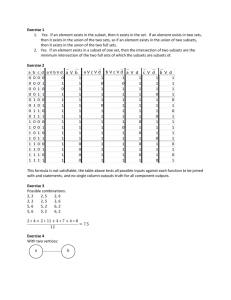Curriculum Burst 79: Cut the Cube
advertisement

Curriculum Burst 79: Cut the Cube By Dr. James Tanton, MAA Mathematician in Residence Three distinct vertices of a cube are chosen at random. What is the probability that the plane determined by these three vertices contains points inside the cube? QUICK STATS: MAA AMC GRADE LEVEL This question is appropriate for the lower high-school grade levels. MATHEMATICAL TOPICS Geometry; Probability. COMMON CORE STATE STANDARDS G-GMD.4 Identify the shapes of two-dimensional cross-sections of three-dimensional objects, and identify threedimensional objects generated by rotations of two-dimensional objects. S-CP.9 Use permutations and combinations to compute probabilities of compound events and solve problems. MATHEMATICAL PRACTICE STANDARDS MP1 MP2 MP3 MP7 Make sense of problems and persevere in solving them. Reason abstractly and quantitatively. Construct viable arguments and critique the reasoning of others. Look for and make use of structure. PROBLEM SOLVING STRATEGY ESSAY 4: SOURCE: 1 DRAW A PICTURE This is question # 24 from the 2009 MAA AMC 10A Competition. THE PROBLEM-SOLVING PROCESS: As always, the best start is … STEP 1: Read the question, have an emotional reaction to it, take a deep breath, and then reread the question. I need to draw a picture. We’re choosing three corners of a cube and are hoping the plane defined by them slices through the interior of the cube. (Have I illustrated essentially all of the cases for a choice of a second vertex?) I have to work out the where the third vertex can go in each of these cases, and then all the probabilities associated with each case. This is getting complicated! Rather than count vertices that don’t lie on the same face, would it be easier to count the opposite? What are the chances that the three chosen vertices do lie on the same face? There are 6 faces and for each face there are 4 ways to choose three vertices on it. (The opposite again! There are four options for which vertex on that face not to use.) So there are 6 × 4 = 24 arrangements of three dots all on the same face. How many arrangements of three dots are there in all? Well we have 8 vertices and there are 8! = 56 ways to 3!5! select three of them. So the probability of choosing three I see that whenever the three chosen vertices lie on the same face of a cube, the plane they define fails to cut slice through the interior of the cube. (And conversely, if a plane fails to cut through the interior of the cube it must be passing through the vertices of a face.) Okay. So we need to find the probability that the three vertices we choose don’t lie on a common face. Hmm. Well, we can choose any first vertex we like. The second vertex can be any other vertex. The crux of the matter is the choice of the third vertex then – but I think that depends on the choices made with choice of the second vertex. 24 56 vertices on the same face is = 12 3 . = 28 7 The probability we seek is the opposite of this. The chances of having the plane slice through the interior of the cube is: 1− 3 4 =. Done! 7 7 Extension 1: A dodecahedron has 12 faces, each a regular pentagon. The solid has 20 vertices. Three of these 20 vertices are selected at random. What is the probability that the plane they define slices through the interior of the solid? Extension 2: Four of the 20 vertices of a dodecahedron are selected at random. What is the probability that these vertices all lie in the same plane? Curriculum Inspirations is brought to you by the Mathematical Association of America and the MAA American Mathematics Competitions. 2 MAA acknowledges with gratitude the generous contributions of the following donors to the Curriculum Inspirations Project: The TBL and Akamai Foundations for providing continuing support The Mary P. Dolciani Halloran Foundation for providing seed funding by supporting the Dolciani Visiting Mathematician Program during fall 2012 MathWorks for its support at the Winner's Circle Level 3








